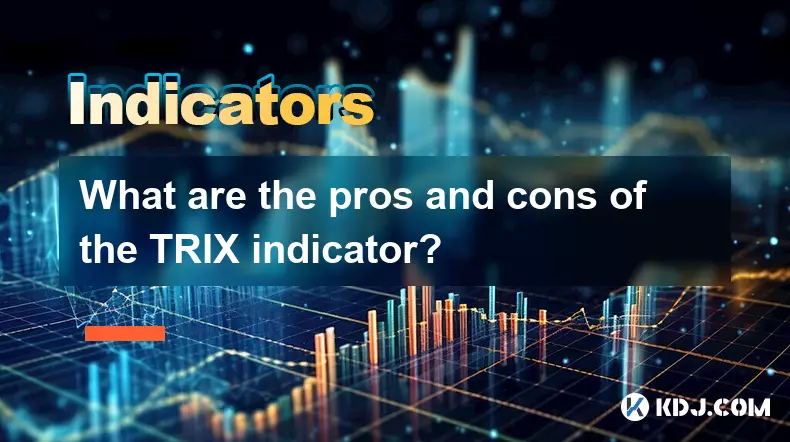-
 bitcoin
bitcoin $100977.009184 USD
-2.05% -
 ethereum
ethereum $3282.009150 USD
-3.23% -
 tether
tether $0.999813 USD
-0.02% -
 xrp
xrp $2.208254 USD
-4.89% -
 bnb
bnb $951.411089 USD
0.55% -
 solana
solana $155.761205 USD
-2.84% -
 usd-coin
usd-coin $1.000217 USD
0.02% -
 tron
tron $0.284475 USD
-1.28% -
 dogecoin
dogecoin $0.162363 USD
-1.53% -
 cardano
cardano $0.533988 USD
-0.47% -
 hyperliquid
hyperliquid $39.174339 USD
-3.22% -
 chainlink
chainlink $14.724828 USD
-1.16% -
 bitcoin-cash
bitcoin-cash $477.297986 USD
-1.28% -
 zcash
zcash $554.227426 USD
17.30% -
 ethena-usde
ethena-usde $0.998995 USD
-0.03%
What is the formula behind the TRIX indicator calculation?
The TRIX indicator uses triple exponential smoothing to filter noise and identify momentum shifts, making it valuable for spotting trends and reversals in volatile crypto markets.
Nov 06, 2025 at 08:39 pm

Understanding the TRIX Indicator
1. The TRIX indicator, also known as the Triple Exponential Average, is a momentum oscillator used in technical analysis to identify oversold and overbought markets, as well as potential trend reversals. It filters out minor price movements by applying triple exponential smoothing to the closing prices. This process reduces market noise and highlights significant trends. Traders use TRIX primarily to detect divergences between price action and momentum.
2. The calculation begins with selecting a period, typically 14 or 15 days. A single exponential moving average (EMA) is applied to the closing prices over this period. Then, a second EMA is calculated using the results of the first EMA. Finally, a third EMA is derived from the second, creating a smoothed line that responds slowly to price changes. The rate of change of this triple-smoothed EMA forms the basis of the TRIX value.
3. Because it applies three layers of smoothing, TRIX reacts more slowly than other oscillators like MACD or RSI. This makes it particularly useful in volatile markets such as cryptocurrency trading, where false signals are common. By focusing on sustained momentum shifts rather than short-term fluctuations, TRIX helps traders avoid premature entries or exits based on erratic price swings.
The Mathematical Formula Behind TRIX
1. Let Close represent the closing price for each period. The first step involves calculating the first EMA: EMA1 = EMA(Close, n), where n is the chosen lookback period.
2. Using EMA1 as input, compute the second EMA: EMA2 = EMA(EMA1, n). This further smooths the data and removes additional volatility.
3. Apply the EMA function again to EMA2: EMA3 = EMA(EMA2, n). Now you have a triple-exponentially smoothed series that captures only major directional moves.
4. The TRIX value is then derived as the percentage rate of change between consecutive values of EMA3: TRIX = (EMA3_current - EMA3_previous) / EMA3_previous * 100. This result is often plotted as a line that oscillates around zero.
5. Some platforms display TRIX as a decimal instead of a percentage. In those cases, the multiplication by 100 is omitted. Additionally, a signal line—usually a 9-period EMA of the TRIX line—is sometimes added to generate trade triggers when the two lines cross.
Application of TRIX in Cryptocurrency Trading
1. In the highly volatile crypto markets, TRIX can help distinguish genuine trend strength from random price spikes. For instance, during a prolonged Bitcoin rally, TRIX may remain positive even through pullbacks, indicating underlying bullish momentum despite temporary corrections.
2. When the TRIX line crosses above zero, it suggests increasing upward momentum and may be interpreted as a buy signal. Conversely, a drop below zero indicates bearish momentum building, potentially signaling a sell or short opportunity.
3. Divergence detection is one of TRIX’s strongest features. If the price of Ethereum reaches a new high but TRIX fails to surpass its prior peak, this negative divergence could warn of weakening momentum and an impending reversal.
4. Since TRIX relies on multiple smoothing stages, it tends to lag behind price. Therefore, it should not be used in isolation. Combining TRIX with volume indicators or support/resistance levels improves accuracy in identifying valid setups within fast-moving digital asset markets.
5. Altcoins with low liquidity often exhibit erratic behavior that can distort TRIX readings. Traders should adjust the period length depending on the asset's volatility; longer periods provide more reliable signals for stable coins like USDT-linked pairs, while shorter settings may suit aggressive altcoin strategies.
Frequently Asked Questions
What does a flat TRIX line indicate?A flat TRIX line suggests that the triple-smoothed average is not changing significantly, meaning there is little to no momentum in the current trend. This condition often occurs during consolidation phases in crypto assets, where price moves sideways without clear direction.
Can TRIX be used on intraday charts for cryptocurrencies?Yes, TRIX can be applied to intraday timeframes such as 15-minute or hourly charts. However, due to its inherent lag from triple smoothing, signals may arrive late. Day traders often combine it with faster oscillators or candlestick patterns to confirm entries.
Is TRIX effective for detecting bull runs in Bitcoin?TRIX can help confirm ongoing bull momentum once a strong uptrend is established. Sustained positive values above zero reflect persistent buying pressure. A crossover back above zero after a prolonged downturn may signal the start of a new bullish phase.
Disclaimer:info@kdj.com
The information provided is not trading advice. kdj.com does not assume any responsibility for any investments made based on the information provided in this article. Cryptocurrencies are highly volatile and it is highly recommended that you invest with caution after thorough research!
If you believe that the content used on this website infringes your copyright, please contact us immediately (info@kdj.com) and we will delete it promptly.
- Layer 2 Coins: Will There Be a Potential Explosion by 2026?
- 2025-11-07 16:50:02
- Filecoin, ICP, and the AI Infrastructure Renaissance: Is History Repeating?
- 2025-11-07 16:50:02
- Bitcoin's Wild Ride: Surges, Zeros, and the Search for Stability
- 2025-11-07 17:05:01
- XRP, Bitcoin, and the Rally: What's the Deal, New York?
- 2025-11-07 17:25:01
- Filecoin, DePIN, and a Technical Breakout: What's the Buzz?
- 2025-11-07 17:05:01
- Bitcoin Wobbles: ETF Outflows and the $100K Line in the Sand
- 2025-11-07 18:05:01
Related knowledge

How do professional traders use the TRIX indicator?
Nov 06,2025 at 04:40pm
Understanding the TRIX Indicator in Crypto TradingThe TRIX (Triple Exponential Average) indicator is a momentum oscillator used by professional trader...

How to code a simple TRIX indicator script in Pine Script?
Nov 07,2025 at 06:20am
How to Code a Simple TRIX Indicator in Pine Script The TRIX (Triple Exponential Moving Average) indicator is widely used in cryptocurrency trading to ...

How to trade TRIX indicator signals on the 1-hour chart?
Nov 07,2025 at 05:39am
Bitcoin's Role in Decentralized Finance1. Bitcoin remains the cornerstone of decentralized finance, serving as a benchmark for value and security acro...

Can the TRIX indicator be used for long-term investing?
Nov 06,2025 at 02:19pm
Understanding the TRIX Indicator in Cryptocurrency Markets1. The TRIX (Triple Exponential Average) indicator is a momentum oscillator designed to filt...

How to customize TRIX indicator settings for different assets?
Nov 06,2025 at 03:39pm
Understanding the TRIX Indicator in Cryptocurrency Trading1. The TRIX (Triple Exponential Average) indicator is a momentum oscillator designed to filt...

What are the pros and cons of the TRIX indicator?
Nov 07,2025 at 03:40pm
Understanding the TRIX Indicator in Cryptocurrency TradingThe TRIX (Triple Exponential Average) indicator is a momentum oscillator used by traders to ...

How do professional traders use the TRIX indicator?
Nov 06,2025 at 04:40pm
Understanding the TRIX Indicator in Crypto TradingThe TRIX (Triple Exponential Average) indicator is a momentum oscillator used by professional trader...

How to code a simple TRIX indicator script in Pine Script?
Nov 07,2025 at 06:20am
How to Code a Simple TRIX Indicator in Pine Script The TRIX (Triple Exponential Moving Average) indicator is widely used in cryptocurrency trading to ...

How to trade TRIX indicator signals on the 1-hour chart?
Nov 07,2025 at 05:39am
Bitcoin's Role in Decentralized Finance1. Bitcoin remains the cornerstone of decentralized finance, serving as a benchmark for value and security acro...

Can the TRIX indicator be used for long-term investing?
Nov 06,2025 at 02:19pm
Understanding the TRIX Indicator in Cryptocurrency Markets1. The TRIX (Triple Exponential Average) indicator is a momentum oscillator designed to filt...

How to customize TRIX indicator settings for different assets?
Nov 06,2025 at 03:39pm
Understanding the TRIX Indicator in Cryptocurrency Trading1. The TRIX (Triple Exponential Average) indicator is a momentum oscillator designed to filt...

What are the pros and cons of the TRIX indicator?
Nov 07,2025 at 03:40pm
Understanding the TRIX Indicator in Cryptocurrency TradingThe TRIX (Triple Exponential Average) indicator is a momentum oscillator used by traders to ...
See all articles










































































